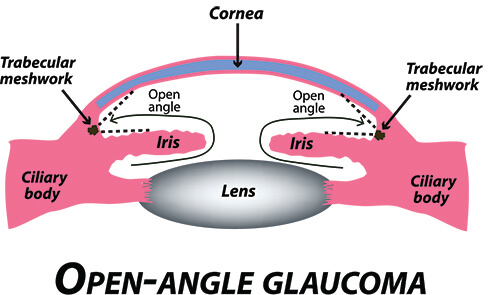Home | Glaucoma
Glaucoma
What is Glaucoma?
Glaucoma is a group of diseases that damage the optic nerve at the back of the eye. The optic nerve transmits visual information from your eye to the brain.
When the optic nerve suffers damage, it can no longer send signals to the brain for the vision process to occur. Most glaucoma occurs because of high intraocular pressure (IOP).
The disease can occur with normal or low pressure as well. Many patients do not have symptoms of vision loss in the early stage of glaucoma.
For many patients, by the time they realize vision loss has occurred, the damage has already begun. If left untreated, glaucoma can result in a serious loss of vision and blindness.
Is Everyone At Risk For Glaucoma?
It is estimated that glaucoma affects nearly three million Americans. Although everyone, young and old, can be at risk, some groups of people are more likely to develop the condition, including:
- African Americans
- People of a Hispanic/Latino background
- Adults over 60 years old
- Those with a family history of glaucoma
- People with diabetes and high blood pressure
People in these risk groups need to have frequent comprehensive eye examinations to check for the early stages of glaucoma.
What Are The Types Of Glaucoma?
Open-Angle Glaucoma
Open-Angle Glaucoma is the most common form of glaucoma. With this type of disease, the eye’s fluid drainage canals become clogged over time. Most people do not notice early symptoms because glaucoma attacks peripheral vision before affecting central vision.
Angle-Closure Glaucoma
Angle-Closure Glaucoma is less common but far more dangerous. A rapid increase in eye pressure occurs suddenly because the fluid in the eye cannot drain.
There are usually no warning signs before this happens. The symptoms include severe eye or head pain, sudden loss of vision, blurry vision, and nausea.
Patients with these symptoms should call their eye doctor right away. Angle-closure glaucoma is a medical emergency and requires immediate medical treatment to avoid severe vision loss. Prompt laser treatment and medications can usually clear the fluid blockage and lower the eye pressure.
Low or Normal-Tension Glaucoma occurs when people experience damage to the optic nerve or side vision loss even if they have normal eye pressure.
Congenital Glaucoma is a condition that occurs when children are born with a defect in the angle of the eye that interferes with fluid drainage.
Secondary Glaucoma is caused by other diseases or treatments, such as high blood pressure, diabetes, complications of cataract surgery, uveitis inflammation, and steroid medications.
Is Glaucoma Preventable?
Most types of glaucoma aren’t preventable. However, early detection and treatment can usually control the disease before severe vision loss occurs. Many patients do not notice that their vision has changed because glaucoma typically affects side vision first.
Ophthalmologists recommend that everyone over the age of 40 have an annual comprehensive eye examination. Besides checking your eye pressure, your doctor will dilate your pupils with eye drops to check the condition of your optic nerve.
How Is Glaucoma Treated?
There is no cure for glaucoma, but its effects are controllable. Every type of treatment has risks and benefits. Your doctor at Joshi Eye Institute can explain the most appropriate options for you.
Glaucoma is commonly treated by lowering or regulating the pressure in the eye. High intraocular pressure is usually caused by fluid in the eye not draining properly. Doctors use three different methods to lower pressure:
Medications
Eye drops or pills are almost always the first treatment that eye doctors try when treating glaucoma. There are a wide variety of drugs that lower eye pressure effectively. Some reduce the amount of fluid the eye produces, and others help fluid drain from the eye.
Treating glaucoma using medication is only effective when patients use their eye drops as prescribed. This means taking them every day. If you experience side effects such as eye redness and stinging, there are many other drug options that your doctor can try.
Laser Treatment
Selective Laser Trabeculoplasty (SLT) is used for patients with open-angle glaucoma when eye drops don’t lower eye pressure enough. With this painless office procedure, your doctor uses a special lens. Then, they’ll apply an intense beam of light to the drainage system of the eye, which improves function.
Micro-Invasive Glaucoma Surgery (MIGS)
A variety of new micro-invasive surgical treatments have been developed in the last ten years. These procedures can be effective in reducing intraocular pressure (IOP) with lower risks than traditional surgery.
Trabeculectomy Surgery
Trabeculectomy surgery has been performed for many years when medical and laser treatments have failed. With this procedure, the surgeon creates a new channel for the fluid to drain from the eye.
While usually effective, there is a high risk of complications. If you have questions or concerns about glaucoma, schedule an appointment at Joshi Eye Institute in Boynton Beach, FL!






